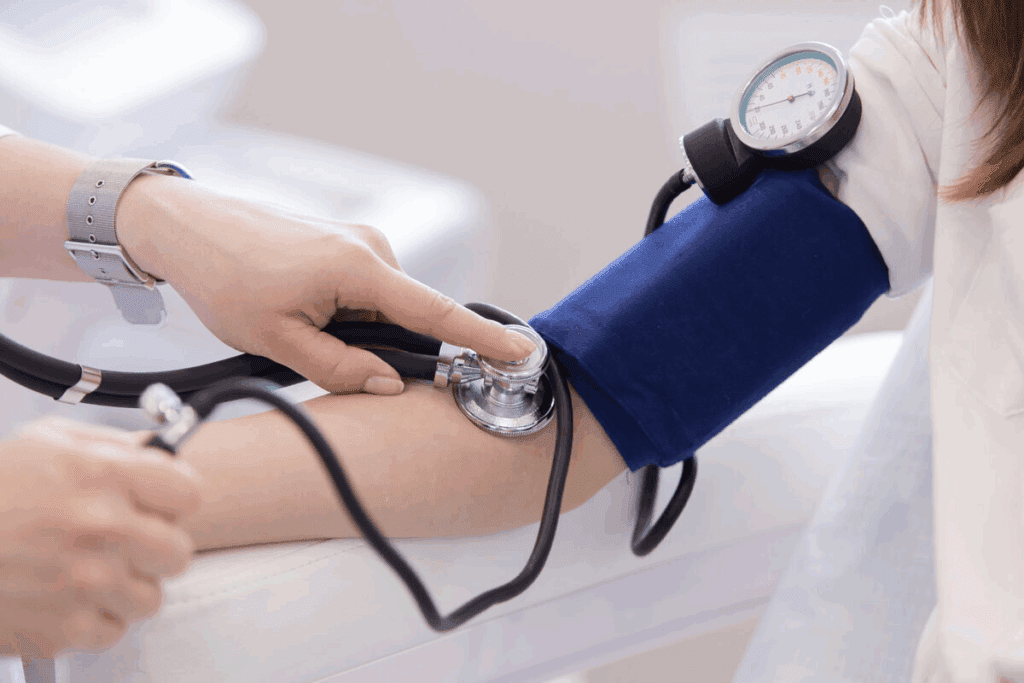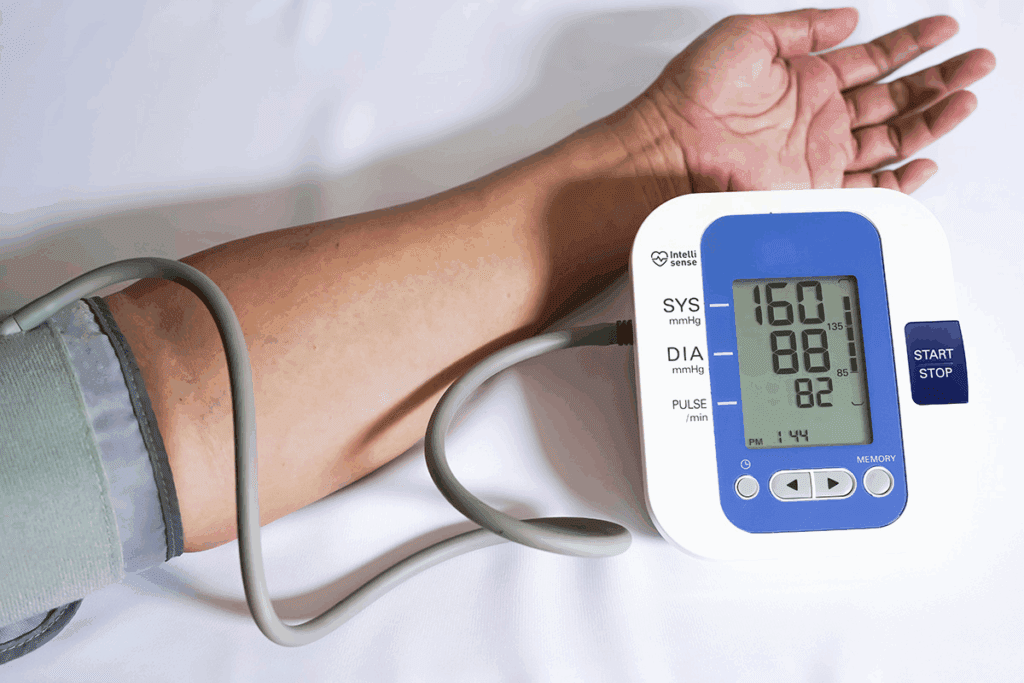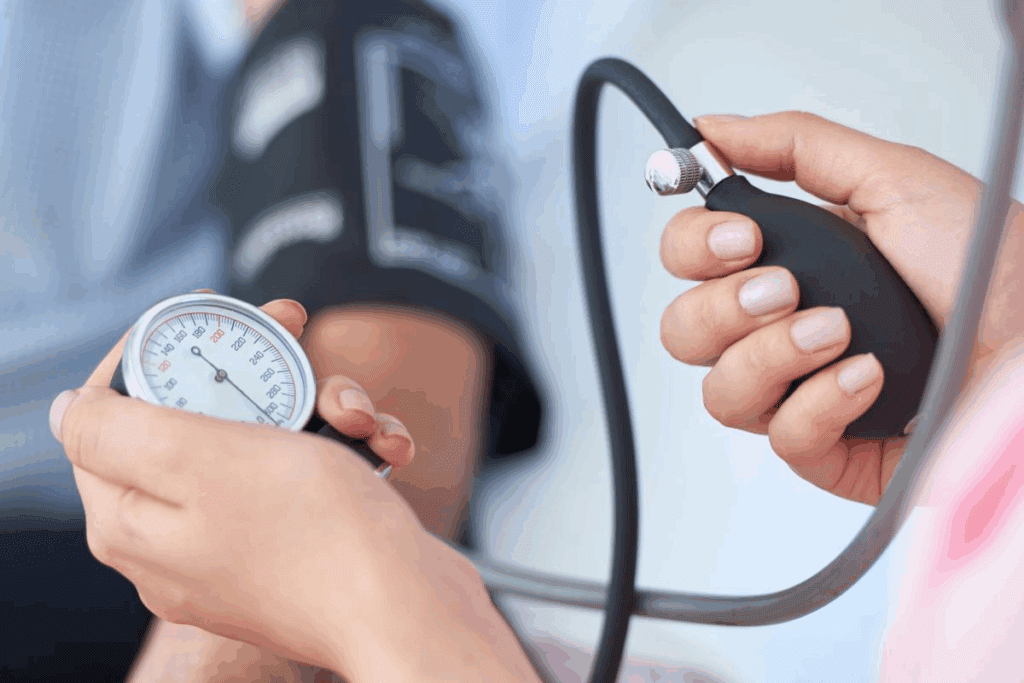Last Updated on November 25, 2025 by Ugurkan Demir

Discover the highest blood pressure ever recorded and how doctors measured and managed the condition.
At LivHospital, we’ve seen extreme cases of high blood pressure. We measure blood pressure with a cuff on the brachial artery. This gives us systolic and diastolic readings.
Normal blood pressure is below 120/80 mmHg. But, it can spike to very high levels during intense activities. Our team is ready to handle these emergencies.

Knowing about blood pressure is key to spotting and treating high blood pressure. It’s a vital part of health care. It tells us a lot about our heart health.
Blood pressure is checked with a device called a sphygmomanometer. It can be old-school or high-tech. The reading is in millimeters of mercury (mmHg). It has two numbers: the top one is systolic, and the bottom is diastolic.
The systolic number shows the heart’s beat force on artery walls. The diastolic number shows the force between heartbeats. Getting this right is important for health checks.
The numbers from a blood pressure test tell us a lot about our heart health. A reading of 120/80 mmHg is usually good. But, it can change based on age, fitness, and health history.
The American Heart Association sets blood pressure levels. Here’s what they are:
| Blood Pressure Category | Systolic mmHg | Diastolic mmHg |
| Normal | <120 | <80 |
| Elevated | 120-129 | <80 |
| Stage 1 Hypertension | 130-139 | 80-89 |
| Stage 2 Hypertension | ≥140 | ≥90 |
Knowing these levels is key to handling high blood pressure well. High blood pressure can cause big health problems if not treated.

The highest blood pressure ever recorded in a scientific study is quite interesting. It shows us the limits of human physiology. This extreme reading happened during maximum effort exercise, showing how our bodies react to intense stress.
In a remarkable study, the highest blood pressure reading was 370/360 mmHg. This was during maximum effort leg presses and forceful breathing. It shows the body’s changes during intense exercise.
The study looked at how people react to maximum effort exercises. It showed how blood pressure can spike under such conditions. The reading of 370/360 mmHg is much higher than usual, giving us a glimpse into human resilience.
The measurement was taken during maximum effort leg presses. The participants also did forceful breathing. This led to the extreme blood pressure reading.
This is not something we see every day. The study’s controlled setting allowed for precise measurements. It made the blood pressure reading very reliable.
The study used special equipment and strict verification methods. The tools were set up to handle extreme readings. Multiple checks were done to make sure the data was correct.
The data was also checked against other physiological measurements. This included heart rate and respiratory rate. This thorough approach confirmed the extreme blood pressure reading.
Blood pressure readings have hit very high levels in hospitals, sometimes over 300 mmHg. These extreme cases are not just severe but also pose big challenges for doctors.
There have been cases where blood pressure went over 300/190 mmHg. These situations are very serious and need quick medical help. The reasons for such high readings can include severe high blood pressure, heart disease, and other health problems.
President Franklin D. Roosevelt had very high blood pressure during his presidency. His case shows how important it is to keep an eye on blood pressure, even for public figures.
There have been other cases where people survived very high blood pressure. These stories help doctors understand how to treat such emergencies. They also give insights into managing severe high blood pressure.
Studying these cases helps us learn more about high blood pressure. It also helps doctors improve how they handle similar situations in the future.
Healthcare professionals have shared reports of extreme blood pressure readings. These cases show the challenges in managing such high pressures.
Some cases have shown blood pressure reaching as high as 340/260 mmHg. These extreme levels highlight the serious nature of the conditions being treated.
Extreme blood pressure readings are linked to severe medical conditions or emergencies. The causes can range from hypertensive crises to severe injuries.
Recording these extreme readings is hard, mainly in emergency situations. Here, time is critical, and the main goal is to stabilize the patient.
Healthcare workers face a tough task. They must document accurately while also providing urgent care. This makes these situations very demanding.
Recording the highest blood pressure needs advanced medical tech and careful methods.
Measuring extreme blood pressure levels goes beyond standard tools. It requires specialized equipment and techniques for precise readings under intense conditions.
The tools for extreme blood pressure measurements are very advanced. Intra-arterial catheters offer direct and continuous monitoring. This is key during maximum exertion or in critical care.
Measuring blood pressure during intense activity follows specific protocols. Automated blood pressure monitors are used. They can take readings fast and accurately, even during hard exercise.
It’s vital to ensure blood pressure measurements are accurate in extreme conditions. For example, multiple readings are taken to confirm the accuracy of the measurement.
| Measurement Method | Description | Advantages |
| Intra-arterial Catheter | Direct measurement of blood pressure through a catheter inserted into an artery. | Continuous and accurate monitoring, useful in critical care. |
| Automated Blood Pressure Monitors | Devices that automatically measure blood pressure. | Quick and reliable. |
It’s important to know about extreme blood pressure for athletes and people with high blood pressure. This condition can happen in different situations, like intense workouts or health problems.
When you exercise hard, your blood pressure goes up. This exercise-induced hypertension is a natural response to the body’s increased need for oxygen and nutrients. Your heart works harder, which raises your blood pressure.
For example, during the most intense exercise, your blood pressure can go over 250 mmHg. This is usually okay for healthy people, as it goes back to normal after stopping. But it’s key to tell the difference between this and true high blood pressure.
But, high blood pressure can also mean there’s a health problem. Issues like pheochromocytoma, a rare tumor, or severe kidney disease can cause very high blood pressure.
These problems need quick medical help. Pathological hypertension can cause heart attacks, strokes, and kidney failure if not treated right.
It’s also important to know if high blood pressure is just for a moment or if it keeps happening. Momentary high readings might happen during hard exercise or stress. But if it keeps happening, it could mean a serious health issue.
Knowing why your blood pressure is high is key to managing it right. This helps doctors give the best care for your specific situation.
Extreme blood pressure levels are a big health risk. But, with rapid medical intervention, more people are surviving. The main thing is getting the right treatment fast.
When someone has a hypertensive crisis, they need help right away. The goal is to reduce blood pressure safely. This helps avoid damage to important organs like the heart and brain.
Doctors use intravenous medications to lower blood pressure quickly. They pick the right medicine based on the patient’s situation. Keeping a close eye on the patient’s blood pressure and health is key.
There are stories of people surviving high blood pressure with the right care. These stories show how important quick and good treatment is. For example, a study in a medical journal told about a patient who made it through a hypertensive crisis.
How well someone does after extreme blood pressure can vary. Some fully recover, but others face lasting health problems. It’s important to keep up with care to manage blood pressure and prevent more crises.
In short, surviving extreme blood pressure needs fast and effective medical help. With the right care and follow-up, people can get better and avoid future crises.
It’s important to know about hypertensive crisis to handle its risks and effects. This is a serious medical issue that needs quick action.
A hypertensive crisis happens when blood pressure goes over 180/120 mmHg. It’s split into two types: hypertensive emergency and hypertensive urgency. Hypertensive emergency shows damage to organs, while hypertensive urgency doesn’t.
Hypertensive crisis poses serious risks. If not treated fast, it can cause a lot of harm. The dangers include:
Knowing the signs of hypertensive crisis is key to acting quickly. Symptoms include:
When a hypertensive crisis happens, you must act fast. Here’s what to do:
Quick action to hypertensive crisis can greatly improve results and avoid serious problems.
Understanding the highest blood pressure ever recorded is key to grasping hypertension’s complexity. We looked at the extremes of blood pressure readings. This includes record high blood pressure values from scientific studies and clinical settings.
At Liv Hospital, we know how critical managing extreme blood pressure is. We provide top-notch care for patients with hypertension. Our team uses the latest medical advancements to treat record high blood pressure effectively.
By studying the physiological contexts and medical implications of extreme blood pressure, we gain insight. This helps us develop effective treatment strategies. It shows the importance of ongoing research and expertise in managing the highest blood pressure.
The highest blood pressure ever recorded was 370/360 mmHg. This was during maximum effort exercise in a scientific study.
Blood pressure is measured with a sphygmomanometer. It shows systolic and diastolic pressures. The systolic pressure is the higher number, showing artery pressure when the heart beats. The diastolic pressure is the lower number, showing artery pressure between beats.
Blood pressure categories include normal, elevated, stage 1 hypertension, and stage 2 hypertension. Normal blood pressure is below 120/80 mmHg. Stage 2 hypertension is 140/90 mmHg or higher.
High blood pressure increases the risk of stroke, heart failure, kidney damage, and other heart diseases.
Hypertensive crisis is when blood pressure is over 180/120 mmHg. It often needs immediate medical attention to prevent serious problems.
Warning signs include severe headache, dizziness, chest pain, shortness of breath, and confusion. It’s important to recognize and respond quickly.
Healthcare professionals use special equipment and follow certain protocols to measure extremely high blood pressure. This is important, even during maximum exertion, to ensure accurate readings.
Extreme blood pressure can happen during intense exercise or due to severe hypertension. Understanding these situations is key for effective management.
Long-term outcomes depend on quick and effective treatment. With the right care, some can recover. But, there’s a risk of lasting heart damage.
Liv Hospital offers full care for hypertension, including emergency response for hypertensive crises. We use our expertise to provide top-notch treatment and support.
Subscribe to our e-newsletter to stay informed about the latest innovations in the world of health and exclusive offers!